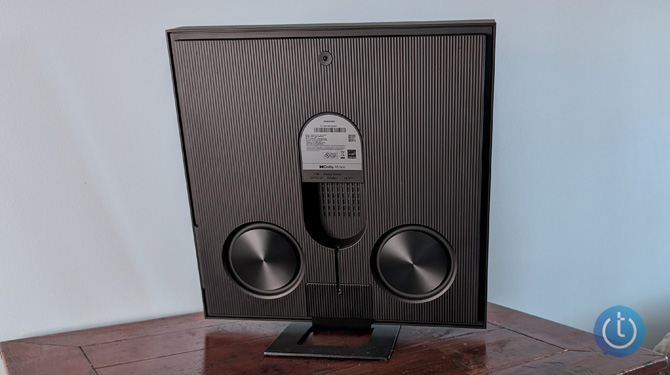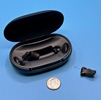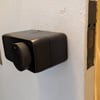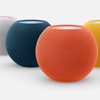We may earn commissions when you buy from links on our site. Why you can trust us.
Samsung Music Frame Review: An Innovative Blend of Sound and Style
Integrating wireless speakers into a well-designed living space can be a challenge, as the aesthetic appeal of the room often clashes with the practical need for high-quality audio. The Samsung Music Frame solves this problem by combining a wireless speaker with a customizable photo frame, providing a solution that blends well with most home decor.

The Music Frame's unique design allows you to personalize it with your favorite photos or artwork – whether a family photo or a majestic beast, as in my photo above. There is also the potential for further customization through interchangeable bezels in the future. This design flexibility is coupled with an overall enjoyable sound, which I discovered in my testing. The Music Frame also offers advanced features like Dolby Atmos and Q-Symphony. These aspects make the Music Frame an intriguing product for those seeking a balance between form and function in their smart speaker.
| + Pros | – Cons | ||
|
|
||
|
|||
Design and customization
Taking it out of the box, I was surprised by the music frame's 9.3lb weight. This is a solid piece of audio gear. And when placed on the included stand, it's quite sturdy.
Everything looks and feels like a premium product. The 13.8 (H) x 13.8 (W) x 2.1 (D) inch frame is well-constructed out of high-quality plastic, as is the mat around the photo. The plastic photo cover has a matte finish, which dramatically reduces glare.
Customizing your photo is a simple process; the mat is attached to the frame using four plastic pegs that hold firmly yet are easy to remove. Behind the mat, there is a back plate that can be pulled off to change out the photos. The plate accommodates 8x10-inch photos, although only a square 8x8-inch portion is visible when the mat is in place.
During my testing, I used the Music Frame with its included stand, but it can also be wall-mounted using the provided hardware. Wall mounting is an attractive option for those considering purchasing a pair of Music Frames to use as rear speakers in a surround sound system. Keep in mind that the Music Frame requires external power, so you'll need to manage the thin power cord when wall-mounting the device.
In terms of visual appeal, the Music Frame blends seamlessly with various home decor styles, adding a touch of elegance to any room. If the current black-and-white color combination doesn’t suit your taste, Samsung has announced plans to release more frame color choices, with a white frame option already slated for release in the summer of 2024.
When comparing the Samsung Music Frame to other picture frame speakers on the market, it becomes clear that Samsung has limited competition in this niche. The Ikea SYMFONISK is one alternative, but it offers very limited customization options unless you purchase expensive custom panels from third-party vendors.
Audio performance
Under the hood, the Samsung Music Frame is equipped with a 2.0-channel speaker system, consisting of six speakers in total, arranged in a three-way configuration. The Music Frame's total power output is 120W, providing ample volume to fill medium-sized rooms.

I found that the Samsung Music Frame delivers a satisfying audio experience across a wide range of music genres. I put the device through its paces with a diverse selection of tracks, from the soul-penetrating vocals of Chavela Vargas' "La Llorona" to the driving guitars of Mongolian heavy metal band The HU, as well as tracks specifically mastered for Dolby Atmos music by The Beatles and Pink Floyd.
As a supplemental speaker for casual listening or paired with your surround sound system, most people should be pretty satisfied with both the sound quality and volume, which can get surprisingly loud without getting muddy. This is definitely not an audiophile's speaker, as I often found tinkering with the equalizer in the Smart Things app was necessary to bring out hollow mids or up the base for specific tracks. But it's not trying to be, so I'm okay with that.
When it comes to reproducing Dolby Atmos music, the Music Frame performs admirably, given its size limitations. Tracks from Apple Music, such as The Beatles' "Hey Jude" and Pink Floyd's "Time," exhibited a noticeable level of atmospheric enhancement. However, it's essential to keep realistic expectations, as a single speaker of this size can only do so much in terms of creating an immersive Dolby Atmos experience.
Unfortunately, I was unable to test the Music Frame's performance with Dolby Atmos movie content, as it requires a 2024 Samsung TV for pairing via the Q-Symphony feature. My current setup includes a 2023 Samsung Neo QLED N90C, which is not compatible.
Read more: Samsung OLED S95D: The Best OLED Big Screen Yet?
When comparing the Samsung Music Frame to typical smart speakers like Amazon Echo devices, it's clear that the Music Frame offers significantly better sound quality. Users who prioritize audio performance in their smart speaker setup will appreciate the Music Frame's superiority in this regard.
Connectivity and streaming
The Samsung Music Frame offers a seamless connection process through the Samsung SmartThings app, allowing users to pair the speaker with their other devices using either Bluetooth or WiFi. During my testing, the initial connection process for both Android and iOS devices was smooth and straightforward. Throughout my use of the Music Frame, I did not encounter any issues with streaming glitches or unexpected drops in connectivity.
One of the standout features of the Music Frame is its compatibility with other 2024 Samsung devices through the Q-Symphony feature. This functionality enables the Music Frame to operate as part of a surround sound system when connected to a compatible Samsung TV. Additionally, the Music Frame can work in Group mode when paired with compatible soundbars, allowing for an extended or multi-room music experience.
Unfortunately, I was unable to fully test the Q-Symphony and Group mode features during my review period. As mentioned above, my 2023 model Samsung TV is not compatible with the Q-Symphony feature. Furthermore, while I had access to the new Samsung S800D soundbar, which is supposed to be compatible with the Music Frame, I encountered difficulties getting the two devices to work together in Group mode. It's important to note that both the Music Frame and the S800D soundbar are pre-release test units, and Samsung told us that this compatibility issue should be resolved through a firmware update in the near future.
Read more: Samsung S800D Soundbar Review: Big Sound, Ultra Slim Profile
The Music Frame supports a wide range of popular streaming platforms, including Spotify, Apple Music, and Tidal. During my testing, the streaming experience was consistently high-quality, with no noticeable lag or interruptions.
Smart features
The Samsung Music Frame comes equipped with a choice of Alexa and Bixby voice assistants. Setting up and using these voice assistants is a straightforward process – it’s mainly just a matter of selecting which you want to use in the app. Users can expect the standard set of features and capabilities associated with Alexa and Bixby.
It's worth noting that when the Music Frame was first announced at CES 2024, Samsung mentioned Google Assistant support as an option. However, as of March 1, 2024, Samsung removed Google Assistant from their TVs, and it is not available through the SmartThings app for the Music Frame.
Controlling the Music Frame through the Samsung SmartThings app is a user-friendly experience. After connecting the device to your phone via Bluetooth, you can easily select your input source and begin playing music. The app offers a sound-mode control, allowing you to choose between Standard, Music, and Adaptive Sound+ modes. In my testing, I found that Standard mode provided the best overall sound quality across a variety of music genres and allowed access to the full set of equalizer controls. The Adaptive Sound+ mode, which is designed to optimize sound based on content and your viewing space, did not noticeably improve music sound quality in my experience.
Other settings available in the SmartThings app include voice enhancement and a night mode. The voice enhancement feature is intended to improve dialogue clarity when watching movies or TV shows, but due to the Q-Symphony limitations I encountered with my 2023 Samsung TV, I was unable to fully test this feature. The night mode compresses volume peaks, making it easier to enjoy audio content without disturbing others during late hours.
In addition to its music playback capabilities, the Samsung Music Frame can also be integrated into your SmartThings hub to control various smart home devices. This allows you to create automated routines and control your connected devices through the SmartThings app or using voice commands with the supported voice assistants.
Wrapping it up
The Samsung Music Frame is an innovative and stylish addition to the smart speaker market, successfully combining the functionality of a wireless speaker with the aesthetic appeal of a customizable photo frame. And Samsung did an admirable job making it both look and sound like a premium offering.
While the Music Frame delivers impressive sound quality for its size and offers a range of smart features, it may not be the ideal solution for everyone. The lack of Google Assistant support and compatibility requirements for certain features, such as Q-Symphony, may be drawbacks for some potential buyers.
For those who prioritize style, customization, and integration with the Samsung ecosystem, the Music Frame is a compelling choice. Its premium look and feel, combined with its solid audio performance, make it a worthwhile investment for the right user. I suspect there will be many homes that end up purchasing two of these to use as rear surrounds (provided they have a compatible 2024 TV and soundbar), as well as for general listening in a bedroom or living space. And at a $399.99 launch price, it's not budget-busting, either.
[Image credit: Techlicious]
Josh Kirschner is the co-founder of Techlicious and has been covering consumer tech for more than a decade. Josh started his first company while still in college, a consumer electronics retailer focused on students. His writing has been featured in Today.com, NBC News and Time.

















From Diggerpop on May 04, 2024 :: 5:00 pm
QSymphony was marketed as a connectivity ecosystem thus if you invest in that ecosystem then other items within that ecosystem should be back and forward compatible. Is this technical incompetence on Samsungs behalf as to why this will not connect to a 2023 tv or soundbar with qsymphony or is it corporate greed? Either way it’s incompetence and a bigger outcry needs to be made about this. Sonos ecosystem is effectively backward and forward compatible, qsymphony clearly is not. Would love to hear some official response from Samsung on this for all those who invested in the qsymphony ecosystem in 2023
Reply